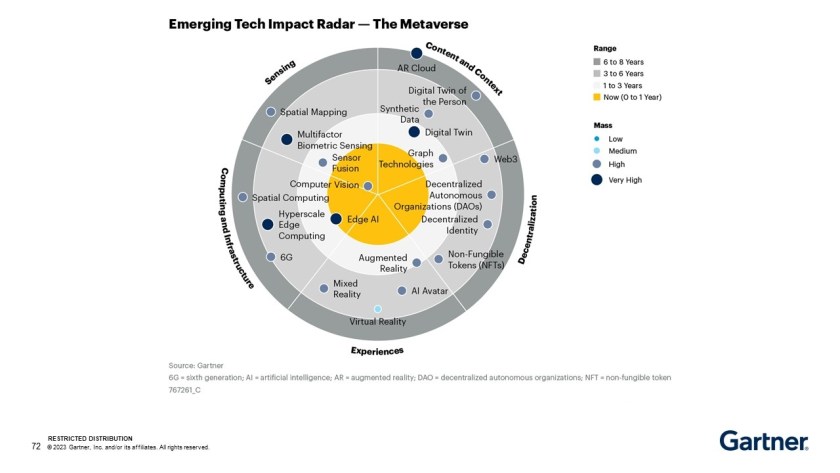This week, I published Emerging Tech Impact Radar — The Metaverse (full report available to subscribing Gartner clients). The metaverse is an evolutionary stage in how we interact with the world around us – specifically how the intersection between physical and digital will change the interactions between people, places and things. While it’s not a formal change, it describes a general change that will happen over time as digital experiences become immersive and interactions change due to persistent, decentralized, collaborative and interoperable digital content; which will overshadow the less immersive experiences of the prior era.
The metaverse is an example of a combinatorial trend in which a number of individually important, discrete and independently evolving trends and technologies interact with one another to give rise to another trend. The metaverse is not able to be completely realized today, but will evolve via precursors in a series of overlapping stages. As this megatrend passes through its first wave of hype, product leaders are tasked with understanding:
- Which emerging technologies and trends (ETT) are most relevant to them in each phase.
- When one or more relevant ETT should be adopted.
- How current offerings and strategic roadmaps fit into the broader metaverse concept.
For the metaverse Impact Radar, I’ve highlighted 21 ETT because these are the ones that will have a very significant cross-pollination effect on the evolution of the metaverse. I’ve grouped the ETT into 5 themes. While these themes represent important aspects of the metaverse, neither the individual ETT highlighted, nor the themes mentioned imply product leaders should focus all investment on a specific theme. We recommend product leaders to evaluate the individual ETT with regards to their product strategy; which may imply evaluating ETT across the 5 themes we have identified here.
Gartner defines the metaverse as an immersive digital environment of independent, yet interconnected networks that will use emerging protocols for communications. It enables persistent, decentralized, collaborative, interoperable digital content that intersects with the physical world’s real-time, spatially indexed and organized content.
Here is our Metaverse Impact Radar (click to enlarge).
Content and Context: The metaverse will contain digital content on a scale that eclipses what exists today. Digital representations of all items and locations within the physical world will be anchored and geoposed through a heterogeneous, but shared point cloud as part of a digital layer that overlaps our physical reality. This layer will not only provide physical items with additional content and context, but include items and information not represented in the physical (such as processes for simulations, storytelling and gaming). To achieve this feat, synthetic data will be used to create better models and explore relationships and interactions when direct, observable data is lacking. Meanwhile graph technologies will provide understanding of the relationships between digital and physical people, places and things.
Decentralization: Decentralization will enable new possibilities in terms of information distribution, encryption, tokenization and immutability, providing new capabilities in managing digital assets and exposing new commercial possibilities. For example, “minimization of trust” will provide a user with direct ownership of their online identity for personal monetization if desired.
Experiences and Interfaces: While there will be a vast range of devices and applications for users to experience the metaverse, the most popular and easy-to-use method will be via immersive technologies. These consist of devices specifically designed for augmented reality (AR), mixed reality (MR) and virtual reality (VR). Additionally, as the world becomes increasingly digitized, interactions in the digital space will not only take place between individuals, but artificial intelligence (AI) avatars that represent aspects of an individual, concept, function, company or group.
Computing and Infrastructure: Many aspects and experiences of the metaverse will develop out of a shift in computing toward more distributed and decentralized processing and storage. Technologies (such as edge and spatial computing) will enable new physical-digital content and interactions; while advances in networking developed out of 6G will allow for experiences beyond what is possible today in terms of bandwidth and latency.
Sensing: Data captured by a multitude of both stationary and nonstationary sensors will provide deeper insight into environmental context, enabling highly personalized interactions within the metaverse. Technologies such as computer vision, sensor fusion, multifactor biosensing and spatial mapping will not only process and segment static and dynamic elements of an environment, but integrate disparate sources of content in a consistent, accurate and useful way.
Recommendations for Product Leaders:
- Create a metaverse strategy by developing a roadmap that clearly defines which technologies and partnerships are required to deliver value in the emerging, advanced and mature stages of the metaverse.
- Review and prioritize investment in metaverse-enabling technologies that add user value when combined with the products or services. While technologies such as virtual reality and head-mounted displays (HMDs) are currently seeing strong marketing/hype, use cases remain limited.
- Invest in exploring new business and monetization models enabled by metaverse-related technologies as the metaverse evolves beyond solving customer challenges today, by focusing on combinatorial technology solutions that can break new ground in value generation or disrupt existing business models.
Gartner Launches Metaverse Emerging Tech Impact Radar


